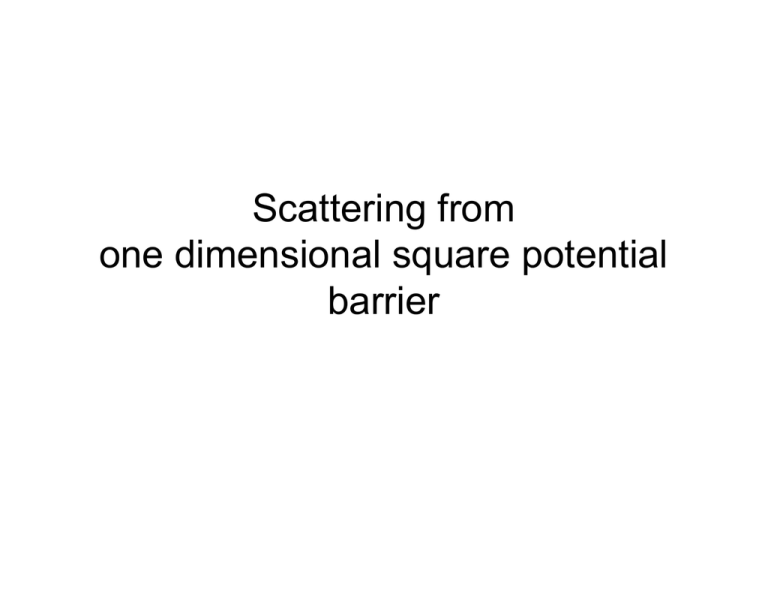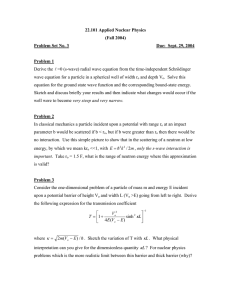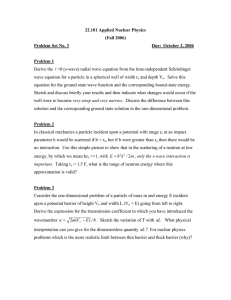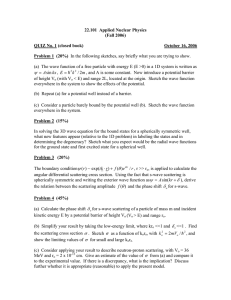One dimensional square potential barrier
advertisement

Scattering from one dimensional square potential barrier Collision theory In a collision problem, the energy is specified in advance and the behavior of the wave function at great distances is found in terms of it. This asymptotic behavior is related to the amount of scattering of the particle by the force field . Application: Collision studies Reactive collisions Fragmentations Tunneling trough the potential barriers, Intersystem crossing One dimensional square potential barrier We make use of stationary solutions of the time-independant wave equation that correspond to particular values of the incident momentum 0 V(x) x<0, x>a V(x)= V0 V0 >0 0<x<a E0 >0 2 h − ∇ 2 Φ ( x ) = EΦ ( x ) 2m 0 0 a x h2 2 − ∇ Φ ( x ) = EΦ ( x ) 2m h2 2 [− ∇ + V ( x )]Φ( x ) = EΦ( x ) 2m Quantum particle approaches from the region of negative x and is reflected or transmitted by the barrier. Asymptotic behavior Particle possesses certain energy E0 >0 and momentum p=hk/2π=(2mE)1/2 – In the regions x<0 the wave function represent particle moving to the right(incident particle) and left (reflected particle); for x>a, wave function should represent a particle moving to the right (transmitted particle). φ ( x ) = Ae ikx + Be − ikx x<=0 x>=a φ ( x ) = Ce ikx The solutions are appropriate for the forcefree regions that are external to any scattering potential – In the force region [0, a] particle has definite momentum and can be represented by a one dimensional momentum eigenfunction φ ( x ) ∝ e ipx / h Moving in positive x direction φ ( x ) ∝ e − ipx / h Moving in negative x direction Normalization Physical meaning of the coefficients A, B, C can be inferred by substituting the wave functions to the one-dimensional probability current density equation ∂ P ( x , t ) + ∇S ( x , t ) = 0 ∂t h S ( x, t ) = [Ψ * ∇Ψ − (∇Ψ*)Ψ ] 2im def This has the familiar form associated with the conservation of flow of a fluid of density P and current density S Probability current density L. Schiff, Quantum Mechanics The rate of change of the number of particles in volume is due entirely to the particle current flowing through the area bounding S(x)=v(IAI2-IBI2) S(x)=vICI2 v=p/m for x<0 for x>0 where v= hk/2πm is the speed of a particle with propagation number k This can be interpreted as the net flux (positive to the right) in the two regions and A, B, C are amplitudes of the incedent, reflected and transmitted wae functions The absolute normalization is not important, since the interest is only in obtaining the reflection and transmission coefficients wich are in the ratios to the incident particle: IBI2/IAI2 , ICI2/IAI2 Solutions inside the potential barrier Character of the solution inside the potential barrier depends on whether E is greater or less than V0. For E>V0 one can obtain the propagation number α=[8π2 m(E-V0)/h]1/2 and the solution inside the barrier is: φ ( x ) = Fe iαx + Ge − iαx 0 <= x <= a The continuity of f and df/dx at x=0 and x=a required by the boundary conditions provides four relations between the five coefficients. Solution: B ( k 2 − α 2 )(1 − e 2iαa ) = A ( k + α )2 − ( k − α )2 e 2 iαa C 4kαe 2 i (α − k )a ) = A ( k + α )2 − ( k − α )2 e 2 iαa The absolute squares of ratios are the scattering (reflection and transmission) coefficients: 4k 2α 2 4 E ( E − V0 ) −1 B −1 ] [ 1 ] = [1 + 2 = + 2 2 2 2 2 A ( k − α ) sin αa V0 sin αa 2 ( k 2 − α 2 )2 sin 2 αa −1 C V0 sin 2 αa −1 ] = [1 + ] = [1 + 2 2 4 E ( E − V0 ) A 4k α 2 2 One can verify that summe of these coefficients gies 1 as would be expected Properties of the solution: For E---Æ V0 the particle energy approaches the top of the barrier: 2 C mV0a 2 −1 →( ) 2 A 2h For E>V0 the transmission coefficient oscillates between a steadily increasing lower enelope and unity (interference phenomena). There is perfect transmission when αa =π, 2π, ... . Whenever the barrier contains an integer number of half wavelengths. It is known as a transmission of light through thin refracting layers For 0<E<V0, the reflection and transmission coefficents are obtained by replacing α by iβ=[8π2 m(V0-E)/h]1/2 C V0 sinh 2 β a −1 = [1 + ] A 4 E (V0 − E ) 2 2 βa>>1 (V0 − E ) − 2 βa 16 E e 2 V0 Tunneling through the barrier The transmission coefficient of a square barrier as a function of particle energy for 4π2 mV0a2/h Scattering of the wave packet The time dependant Schrödinger equation can be used to study the motion of a wave packet: The solution can be expanded in energy eigenfunctions and the summation carried out explicitly. For frre particle is this possible but it is impossible when a potential is present. Other method is based on a numerical integration. The diiferential equation in the time are approximating by a difference equation. see also previous lectures Gaussian wave packet Scattering from a square barrier <E>=1/2V0 Gaussian wave packet Scattering from a square barrier <E>=V0 Figures shows how the probability decays slowely and bounces back and forth within the barrier when the mean kinetic energy of the particle is zero. Gaussian wave packet scattering from a square well <E>=1/2V0 Gaussian wave packet scattering from a square well <E>=V0






